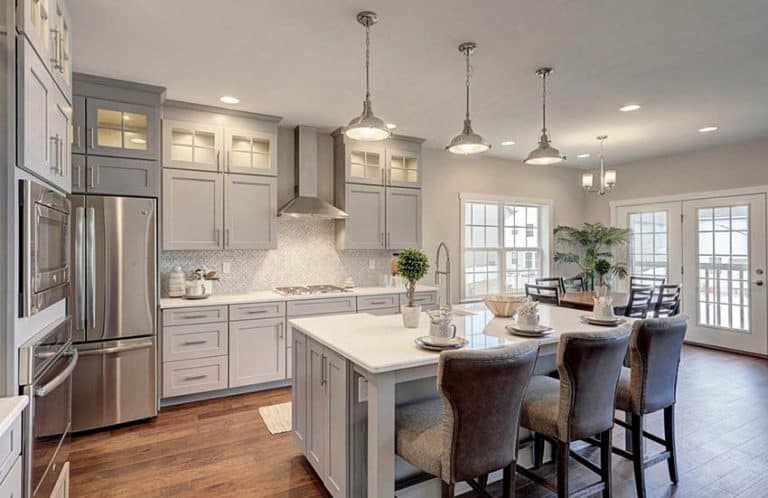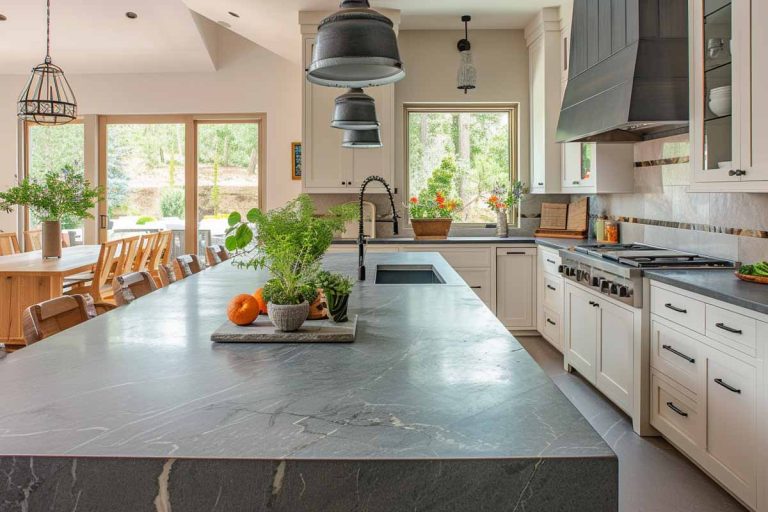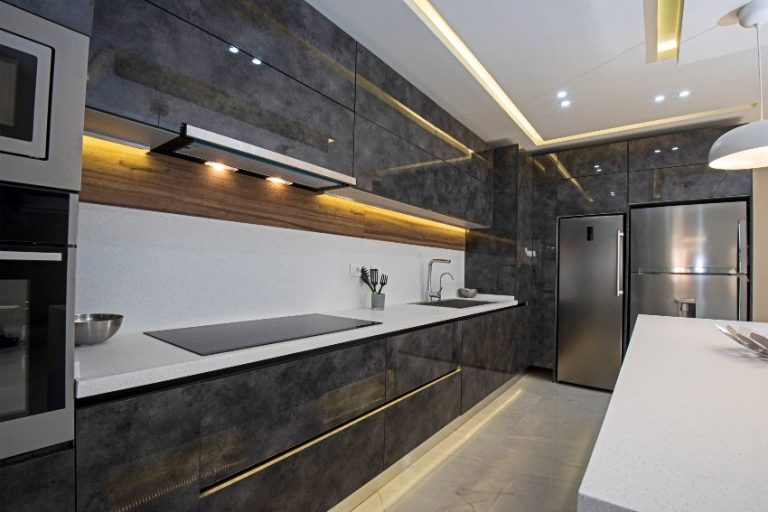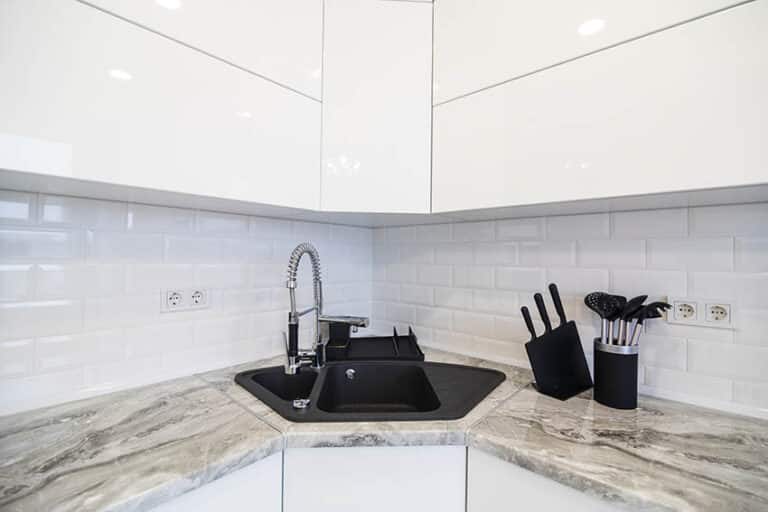Acrylic Kitchen Cabinets (Pros & Cons)
Cabinets are the most dominant feature in the kitchen, and they are simultaneously the home’s central hub. Since they are subjected to daily wear and tear, picking out the best finish is important to always remain in pristine condition. Paints, wood stains, laminates, and veneers are common cabinet finishes. Each comes with practical benefits; however, acrylic kitchen cabinets are one of the most durable and reliable options on the market.
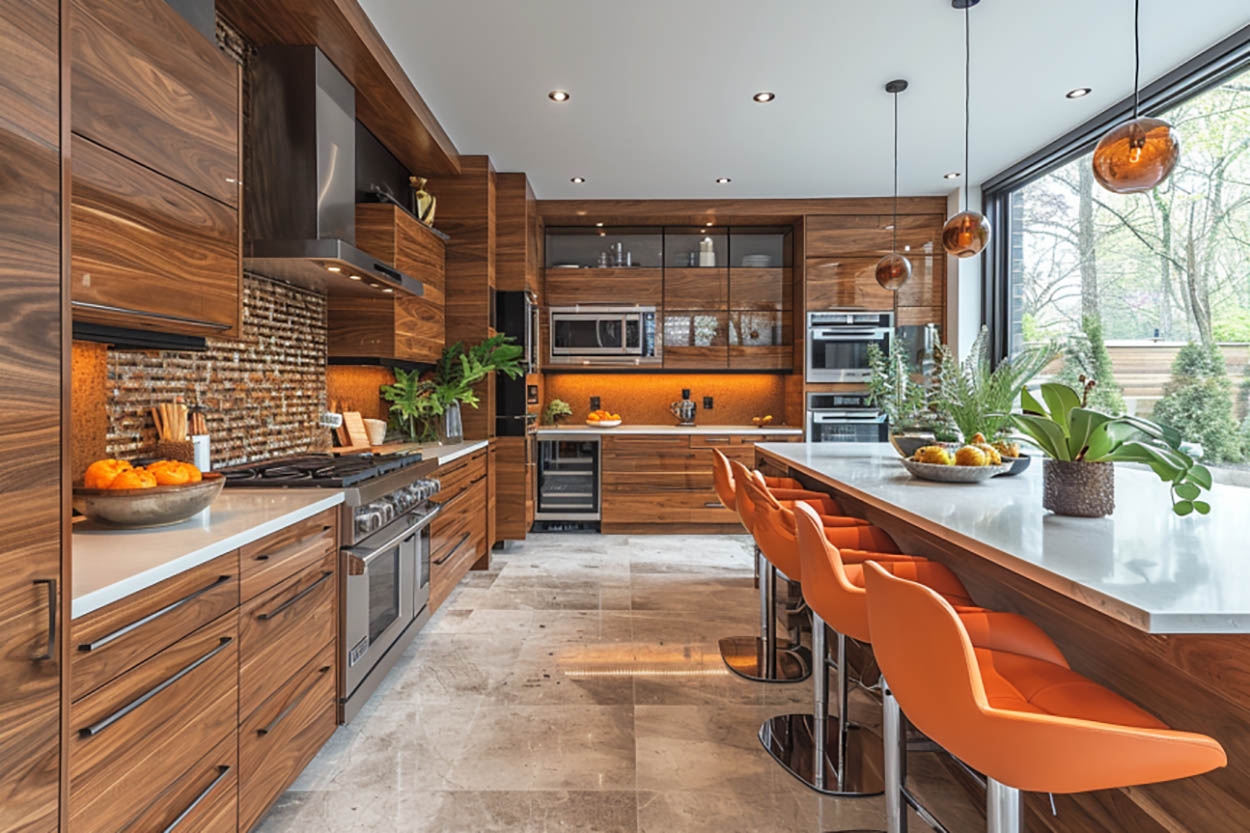
Below, we take a look at the impressive characteristics of acrylic kitchen cabinets, their cost, and how they fare compared to the other kitchen paint options. Read on to learn why they are an excellent choice for your home kitchen.
What Are Acrylic Cabinets?
Acrylic is a non-toxic finish that gives kitchen cabinets a reflective, high-gloss surface and extremely smooth texture. It is essentially a synthetic material that is produced in sheet form.
This premium kitchen cabinet finish is similar to lacquer, which is highly regarded for its premium, mirror-like finish. Acrylic sheets are also available in a wide range of colors and sizes. Read more about our article on lacquer kitchen cabinets here.
Acrylic is extremely durable, shatter-proof, and resistant to cracks and chipping. It is said to be 17 times stronger than glass. Its unparalleled durability comes from hard, high-quality plastic resins. The finish is typically used as an alternative to glass or laminate because of its remarkable visual appeal. Known for their sleek finish and crisp look, these cabinets are common in most modern home kitchens.
Acrylic Cabinet Doors
Acrylic kitchen cabinets have two main types, namely solid-acrylic doors and acrylic-faced doors.
Solid doors are made entirely of an acrylic finish, giving the cabinets a more vivid and vibrant look. On the other hand, acrylic-faced doors are made up of acrylic sheets attached to an MDF board using an adhesive. The sheets are then coated with a protective layer to seal all of their edges.
Overall, solid-acrylic doors are more expensive than acrylic-faced doors.
Acrylic Kitchen Cabinets Pros And Cons
Undoubtedly, acrylic is a worthy investment you can make for your home. Aside from the unique, sophisticated look, it can render to a space, it has other impressive benefits.
Pros of Acrylic:
Here are some of the advantages.
Durability – The material is well-known for its remarkable durability and reliability. It can withstand wear and tear, making it highly suitable for kitchen cabinet applications. Moreover, it is also scratch- and UV light-resistant.
Waterproof – Unlike the other cabinetry finishes, acrylic is waterproof. This means they do not require special treatment or sealant as extra protection. It can also be used for both interior and exterior applications.
Long lifespan – Because of the durability of the finish, the cabinetry tends to be long-lasting. Its appearance, gloss, and color will not fade easily over time.
Easy to clean – One of the most practical benefits is that their surfaces require very little maintenance. For proper cleaning and maintenance, all you need to do is wipe it down with a soft cloth and use some mild soap and water to clean it.
Aesthetics – One of the major reasons people are drawn to this cabinetry is their interesting visual appeal. Most high-end kitchens make use of a premium high gloss finish. Typically, acrylic is their go-to finishing material.
It creates a very elegant atmosphere while creating an illusion of space because of its highly reflective surface. This is the perfect choice if you want to make your kitchen cabinets the focal point of your home. It also contrasts beautifully with a variety of backsplash options. Read more about the various types of kitchen backsplash here.
Available in a wide variety of colors – Acrylic finishes come in a wide variety of colors, which range from versatile neutrals to bright, lively hues. This makes it an ideal option for those who want to maximize customization.
Whether your kitchen has a traditional or modern interior theme, you can find the right color to complement your interior style and color scheme.
UV-resistant – Acrylic has excellent UV resistance. This means their doors can also be installed outdoors, making them perfect for patio kitchens. Its color will not fade nor change even when exposed to direct sunlight.
Lightweight – As a construction material, it is lightweight and can be machined, fabricated, and glued.
Cons Of Acrylic:
Here are some of the disadvantages.
Visibility of stain and dirt – Due to the extremely glossy surface of this cabinetry, dirt, stains, and fingerprints tend to be more noticeable. Thus, they are quite high maintenance for a large family compared to the other kitchen cabinet finishes like paint or wood stain.
Expensive – Overall, acrylic is more expensive compared to the other kitchen cabinet finishes because it is also considered a premium finish.
Difficult to replace – If the need to replace one of your doors arises, it might be difficult to do so. After several years, it will be quite challenging to match the shade of your existing cabinets perfectly. Sometimes, the best solution to maintain a seamless look is to replace all the cabinetry entirely.
Installation – DIY is not an option; installation is best left to the experts. The sheets sometimes do not adhere easily to their cabinet base. To ensure proper application, hiring a professional to do the job would be best.
High Gloss Acrylic
High-gloss acrylic kitchen cabinets are popular choices for most modern and European-style kitchens. This type of finish has a mirror-like semblance and an ultra-shiny appearance, perfect for a clean and seamless look. See more high gloss kitchen cabinets here.
This is perfect if you want to create an illusion of space in your kitchen because it reflects light very well, making the area appear bigger and more open.
Aside from high gloss finishes, the cabinets are also available in other finishes, including matte, semi-gloss, and decorative finishes.
White Acrylic
White remains to be a popular color choice for most kitchen cabinet designs. Regardless of the style, finish, and material, white kitchen cabinets are considered a fail-proof choice because of their design flexibility and timelessness.
White kitchen cabinets, in general, tend never to go out of style. White glossy-acrylic cabinets’ minimalist and crisp aesthetics make them a leading choice for modern kitchens. They also pair well with any interior theme and color scheme.
White offers the most design flexibility and versatility among the color choices for these cabinets. It works like a blank canvas, which presents unlimited mix-and-match options for styling.
It goes well with any backsplash color and blends harmoniously with different countertop choices, wall paints, flooring, and appliances. But it can also stand out remarkably in the space if you contrast it with other design elements.
Aside from contrast, you can also create a stylish, seamless monochromatic palette with these white-acrylic finished cabinets that will go with other finishes, items, and decor pieces. Moreover, they can be a perfect backdrop to introduce a splash of accent colors into the space.
While white may seem too dull or boring, this white cabinetry can make any interior visually interesting because of its high gloss reflective finish.
The shiny white cabinetry can also make a space feel more vibrant, creating a bright, spacious, and inviting atmosphere. It can help enhance the lighting, too, as it tends to reflect light well. In effect, this can also help create an illusion of a bigger space, making it highly suitable for small kitchens.
Acrylic Paint For Cabinets
There are mainly three types of paint, namely oil-based paints, latex-based paint, and acrylic paints. However, oil-based paints are starting to be phased out in the last fifteen years.
When doing home improvement projects, consider using acrylic and latex paints. The main difference is that latex paints are water-based, while acrylic paints are chemical-based.
Acrylic-based paints are pigments suspended in acrylic resin and an acrylic-polymer solution. Acrylic paint also dries very quickly. Because they are chemical-based, they become resistant to water when dry. They do not mix well with oil-based paints and are more challenging to apply in bigger areas.
The components that make up acrylic paints made them more elastic as well. Greater elasticity means the paint expands and contracts better when the temperatures fluctuate. This means the paint will not flake or crack even when exposed to extreme heat or cold, making it excellent for cabinet applications.
Acrylic paints are ideal finish materials for wooden kitchen cabinets. They strongly adhere to wood and are peel-resistant. Although more expensive than other paints, they are extremely durable. When using this type of paint as a finishing for kitchen cabinets, apply at least three coats for extra durability.
These paint products are found in local home improvement stores and hardware stores. Popular brands like Behr, Sherwin Williams, and Valspar all carry these paints in their product line and manufacture them in various colors.
Acrylic Doors for Cabinets
These cabinet doors are typically used in European-style kitchens and are commonly offered by modular kitchen suppliers. They are produced in various colors and finishes—from vibrant reds, electric blues, and bright oranges to neutrals like shades of black, white, and brown.
They are also available in several finish options, including high gloss, semi-gloss, matte, and wood-like finish.
Modular kitchen suppliers and cabinet manufacturers typically make acrylic sheet doors using an MDF base material. However, they can also be used with plywood or solid wood cabinet frames.
Cost Of Acrylic Style Cabinets
The acrylic kitchen cabinets range between $5,000 and $20,000 for the materials and installation. The project’s overall cost will vary greatly depending on the base material or the kitchen cabinet carcass. Since the finish comes in sheets, it can be applied to MDF, metal, or even wood. Typically, those with an MDF substrate are cheaper than those with a solid wood base.
In general, these finishes are more expensive than wood veneers and laminates. But while it is considered a premium finish, it is still often less expensive than real wood or solid wood and stainless steel kitchen cabinets.
Acrylic Vs Wood Cabinets
Before we compare the qualities of acrylic and wood kitchen cabinets, let us first differentiate them in terms of their use in kitchen cabinet construction. The carcass, or the main framework and body of a kitchen cabinet, is typically made of solid wood or wood-like materials. This can be hardwood, particleboard, plywood, or fiberboard.
The carcass serves as the base where the finishing material is applied. The finishing material includes paint, stain, lacquer, veneer, laminate, varnish, or acrylic.
In short, wood is often used as a base material for a kitchen cabinet, whereas acrylic is a type of finish applied on top of the base material. Depending on your personal preference, you can combine both materials to ensure the best quality of your kitchen cabinets.
Real wood or solid wood kitchen cabinets are arguably the most durable material for kitchen cabinets. However, the level of durability of solid wood kitchen cabinets will greatly depend on the type of wood species used.
Hardwoods like hickory and maple are naturally resistant to denting and scratching, as compared to softwoods. Still, softwoods are generally durable and can withstand wear and tear better compared to other kitchen cabinet materials like fiberboard and particle boards.
However, like any other wood material, they are prone to molds, expanding, rotting, and warping. But overall, they tend to be long-lasting, which can last you for decades.
Solid wood pieces are durable and have a distinct natural beauty, adding a warm and inviting feel to a space. While they are considered the best kitchen cabinet case materials, they tend to be expensive.
Acrylic kitchen cabinets with a solid wood base are also very durable. Since solid wood is already naturally resilient on its own, adding a top coat of a sturdy finish like this will reinforce its durability and enhance its quality.
This will also counter the weaknesses of solid wood, such as being prone to moisture damage. The acrylic finish can help protect wood from moisture, which in turn prevents the kitchen cabinets from warping or expanding over time.
Please share your details and experiences or questions in the comments section. Check out our guide on the various types of kitchen cabinet materials for more related content.










